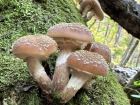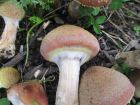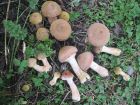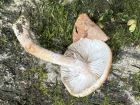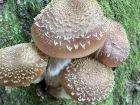Cap initially convex with inrolled margins, then becoming broadly convex or nearly flat. The colour ranges from ochre-brown to red-brown, usually somewhat darker near the centre. Fine brown scales with darker tips cover the cap surfaces. The cap flesh is white and firm. Gills run down the stem or nearly so, closely spaced with frequent short gills. They are whitish, with a tendency to discolour pinkish to brownish. Stem typically club-shaped, often with a swollen base. It is finely lined near the apex and may have a yellow ring zone or occasionally a flimsy white ring with a yellow edge. Above the level of the ring, the stem is pale orange to brown, while below it is whitish or pale pink, becoming greyish-brown at the base. Spore print white.
Microscopic Features: Spores are ellipsoidal and smooth, measuring 7-8.5 x 5-6µm. They are amyloid.
Armillaria gallica on the First Nature Web site.
Armillaria gallica on the MushroomExpert.Com Web site.
The second and third photo is by Dave W and licensed under the Creative Commons Attribution-ShareAlike 3.0 Unported license.
Many mushrooms are poisonous, and some can be lethally toxic. Distinguishing between edible and poisonous mushrooms can be very challenging. Therefore, we strongly advise against consuming wild mushrooms. This website does not contain any information about the edibility or toxicity of mushrooms.
Although efforts have been made to ensure accuracy on this website, the information may contain errors and omissions. Therefore, all content provided is for educational and informational purposes only and should not be relied upon or used as a basis for consuming any plants or mushrooms.
External links are provided for reference only. We do not endorse or take responsibility for the content, advice, or products found on these sites or in any advertisements shown on this website.
